I once rented the wrong trailer for a job I thought was simple.
It was a flatbed. The car I needed to move had low clearance. And halfway through loading, I heard the sickening scrape of metal on metal. That sound still sticks with me.
That day cost me more than money. It cost me time, trust, and a customer I never heard from again.
Since then, I’ve worked with different trailers—on construction sites, in factories, at farms, and even small transport jobs. I’ve seen what works, and what doesn’t.
So if you’re here wondering which car trailer fits your work whether you’re hauling machinery, vehicles, or heavy loads you’re in the right place.
This article breaks down 10 common car trailer types. I’ll explain what each one does, who it’s best for, and what to expect before you hook it up to your vehicle.
By the end, you’ll have the tool you need: a clear understanding of trailer types so you can pick the one that works for your needs.
So let’s start!
1. Quick Comparison Chart
Before we dive into each trailer in detail, here’s a quick side-by-side look. This table gives you a snapshot just enough to start connecting the dots between your needs and what each trailer offers.
| Trailer Type | Towing Style | Deck Height | Axle Type | Best For | Key Benefit |
| Flatbed Trailer | Bumper Pull | ~24″ | Tandem / Triple | Construction, factories, general transport | Easy to load, multi-use |
| Enclosed Trailer | Bumper / Gooseneck | ~30″ | Tandem | High-value cars, retail, weather-sensitive cargo | Full weather and theft protection |
| Tilt Trailer | Bumper / Gooseneck | ~20–24″ (tilts) | Tandem | Low-clearance vehicles, fast solo loading | No ramps, smoother loading |
| Car Hauler (Open Deck) | Bumper Pull | ~18–24″ | Tandem | Auto shops, resellers, quick hauls | Built specifically for cars |
| Gooseneck Trailer | Gooseneck | ~24–30″ | Tandem / Triple | Heavy hauls, multi-car transport, construction jobs | High stability and load control |
| Bumper Pull Trailer | Bumper Pull | ~20–24″ | Single / Tandem | Light jobs, DIY, small equipment | Simple to tow and park |
| Lowboy Trailer | Gooseneck | ~18″ | Tandem / Triple | Tall machinery, mining, oversized equipment | Lower legal height clearance |
| Deckover Trailer | Bumper / Gooseneck | ~32–36″ | Tandem / Triple | Wide cargo, bundled material, fencing | Full-width deck with no fenders |
| Tow Dolly | Bumper Pull | ~10–14″ | Single | Front-wheel-drive cars, RV towing | Lightweight and compact |
| Fifth-Wheel Trailer | Fifth-Wheel Hitch | ~28–32″ | Tandem / Triple | Long hauls, fleet jobs, heavy-duty loads | Best for high control and capacity |
2. Flatbed Car Trailer
A flatbed car trailer is one of the most common trailer types you’ll see.
It has a flat, open deck—no sides, no roof. Just a simple platform to haul vehicles, equipment, or materials.
Flatbeds are made for jobs where height isn’t an issue and where you can easily strap things down.
They’re popular for a reason: they’re straightforward and can carry a wide range of loads.
But that doesn’t mean they’re always the right fit.
How It Works
Loading a flatbed trailer is usually done from the rear using ramps. Some models tilt, but most require you to drive or winch the vehicle up onto the deck.
Once loaded, you’ll secure the car with tie-down straps or chains at key points.
There’s no cover, so you’re fully exposed to weather. That’s something to keep in mind, especially for long trips or hauling valuable cars.
I’ve used a flatbed to haul everything from broken-down sedans to light construction gear. It’s reliable—but also easy to get wrong if you’re not careful with loading angles and clearance.
Key Specs
- Axle Type: Most flatbeds come with tandem axles (two axles), which offer better stability and can carry heavier loads. Some heavy-duty versions use triple axles for added capacity. If you’re moving equipment or multiple cars, tandem is usually enough.
- Deck Height: The deck sits around 2 feet off the ground. This gives enough clearance for loading, but you still need ramps or a tilt option for low-profile vehicles.
- Towing Style: You’ll usually find flatbeds with bumper pull hitches, which attach to a hitch ball at the back of your towing vehicle. Larger or heavier-duty versions may use a gooseneck setup, which connects to a ball hitch in your truck bed. Goosenecks give better stability for long or heavy hauls.
Benefits
- Easy Loading Access: The open deck makes it easier to load from different angles, especially with ramps or forklifts.
- Versatile Cargo Options: You’re not limited to just cars. You can haul lumber, machines, pallets, and more.
- Better Fuel Efficiency: Since there’s no enclosed body, flatbeds catch less wind. That can save fuel on longer trips.
- Simple Maintenance: No side panels, doors, or roof means fewer parts that can break or wear out.
- Budget-Friendly: Flatbeds often cost less upfront compared to enclosed or specialty trailers. For general jobs, that matters.
Ideal Users
- Construction Companies: Perfect for hauling small machines, steel beams, and building materials. Loading is quick, especially when space is tight.
- Logistics & Transportation Providers: Useful for hauling goods that don’t need protection from rain or wind. Great for short-distance delivery routes.
- Manufacturers & Industrial Users: Can move raw materials or finished goods without needing a forklift bay.
- Agriculture & Food Industry: Works well for transporting crates, bales, or light farm tools. But not ideal for sensitive items like fresh produce.
- Individual Buyers: Great choice if you haul a car occasionally, or help friends and family with moves or transport jobs.
Decision Tip
Choose a flatbed trailer if you need a simple way to haul cars, equipment, or materials—and you’re okay with everything being out in the open. But if you’re moving a car with low ground clearance or transporting something that needs weather protection, a flatbed may cause more problems than it solves.
And if you’re looking for a dependable flatbed that fits your specific work Rhinotrail can help you find the right match.
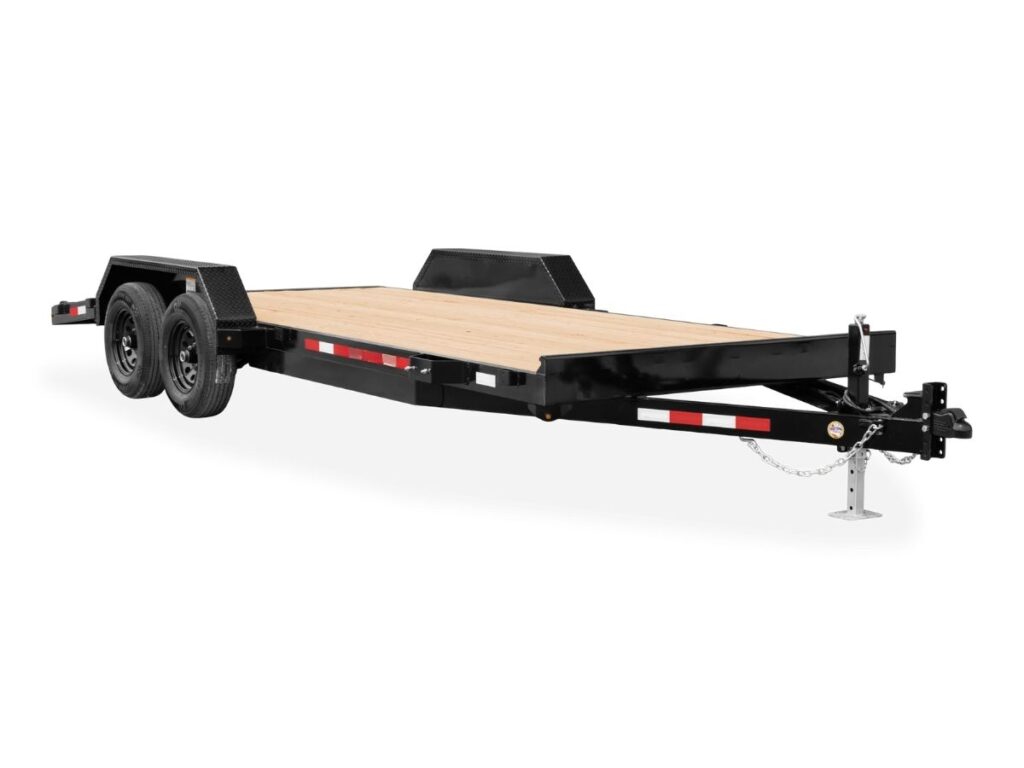
3. Enclosed Car Trailer
An enclosed car trailer has solid walls and a roof. It fully covers the car or cargo inside.
This type of trailer protects your load from weather, dust, and road debris. It’s a go-to choice when the appearance or condition of what you’re hauling matters.
If you’ve ever had to deliver a clean, polished vehicle during a storm, you already know why this trailer exists.
How It Works
You load from the back using a built-in ramp or a rear door that folds down. Some models also have side doors for easier access.
Once the vehicle is inside, you secure it with straps or wheel chocks to keep it from shifting.
There’s usually lighting inside the trailer, which helps if you’re loading in low visibility or working after dark.
I’ve used enclosed trailers for jobs that needed an extra layer of care. One time I had to transport a show car across two provinces. The owner was nervous about scratches or paint damage. That trailer gave both of us peace of mind.
Key Specs
- Axle Type: Tandem axles are standard for better balance and higher weight capacity.
- Deck Height: Slightly higher than a flatbed due to the enclosed frame—around 2.5 to 3 feet.
- Towing Style: Usually bumper pull, though larger enclosed trailers may use gooseneck setups.
Benefits
- Weather Protection: Keeps rain, wind, sun, and snow off your load.
- Security: Hard walls and lockable doors help prevent theft or tampering.
- Cleaner Hauls: Your car arrives just as it left—no dust, mud, or road grime.
- Branding Space: Some businesses use the trailer’s sides for signage or advertising.
- Interior Lighting: Makes it easier to check and adjust your cargo at night.
Ideal Users
- Retail & Auto Distributors: Perfect for transporting new or high-value cars between dealers.
- Logistics Providers: Useful for sensitive deliveries, like electronics or packaged goods.
- Agriculture & Food Industry: Can help move packaged food products or supplies that need cover.
- Manufacturers: Safe way to move finished goods without exposure to the elements.
- Individual Buyers: Good for show cars, motorcycles, or any load you want to protect during travel.
Decision Tip
Choose an enclosed trailer if you need protection from weather or theft, especially for valuable or delicate cargo. But if you’re hauling construction gear or don’t mind the load being exposed, an open trailer might be a more affordable fit.
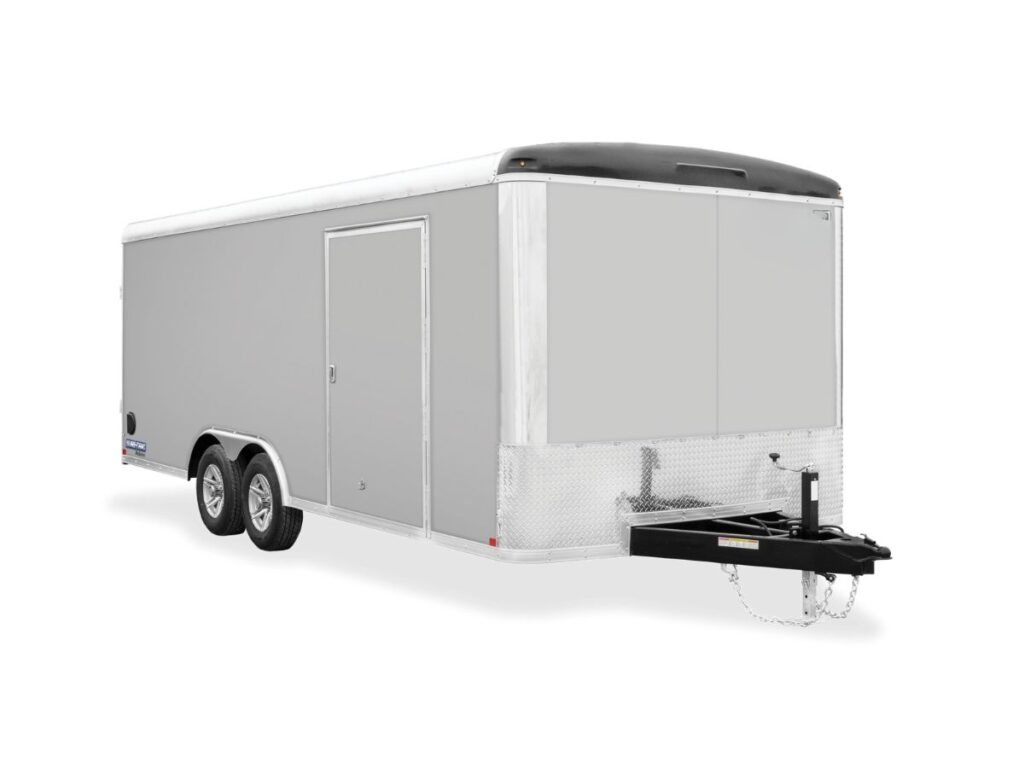
4. Tilt Car Trailer
A tilt car trailer is built with a deck that tilts down to the ground, letting you drive or roll a vehicle right on—no need for ramps.
The whole platform moves, which makes loading simpler, especially for cars with low ground clearance.
It’s designed for quick, easy use. No setup, no hassle.
How It Works
The deck tilts using either gravity, hydraulic assist, or a manual pump system.
You pull a release pin, and the front of the trailer lifts while the back lowers to the ground. This creates a slope so the car can roll or drive smoothly.
Once the car is loaded and balanced over the axles, the deck levels out and locks into place.
I remember using a tilt trailer for a sports car with a very low front end. Traditional ramps were a nightmare always scraping the bumper. But the tilt trailer? It made the whole process smooth and stress-free.
Key Specs
- Axle Type: Most tilt trailers use tandem axles for better stability and weight support.
- Deck Height: Usually sits between 20–24 inches when level; lowers to ground at rear when tilted.
- Towing Style: Most are bumper pull, but larger or heavier-duty tilt trailers may be gooseneck.
Benefits
- No Need for Ramps: The tilt function replaces loading ramps, which means less setup time.
- Better for Low Vehicles: Ideal for cars with low ground clearance no scraping or bottoming out.
- Fast Loading: Great when you’re in a hurry or working alone.
- Fewer Moving Parts: Compared to using ramps, there’s less to carry or misplace.
- Smooth Operation: Hydraulic tilts are easy to use and reduce lifting effort.
Ideal Users
- Individual Buyers: Perfect for personal vehicles like classic cars, sports cars, or motorcycles.
- Construction Companies: Works well for small machinery like skid steers or compact loaders.
- Logistics Providers: Helpful for quick pickups and drop-offs of customer vehicles.
- Manufacturers & Industrial Users: Can safely load equipment that can’t handle steep angles.
- Auto Repair Shops or Tow Services: Easy to move non-running or damaged vehicles.
Decision Tip
Go with a tilt trailer if you’re tired of fiddling with ramps or dealing with clearance issues. But if you usually haul large, heavy loads or need multiple tie-down points, you might want to consider a flatbed or lowboy instead.
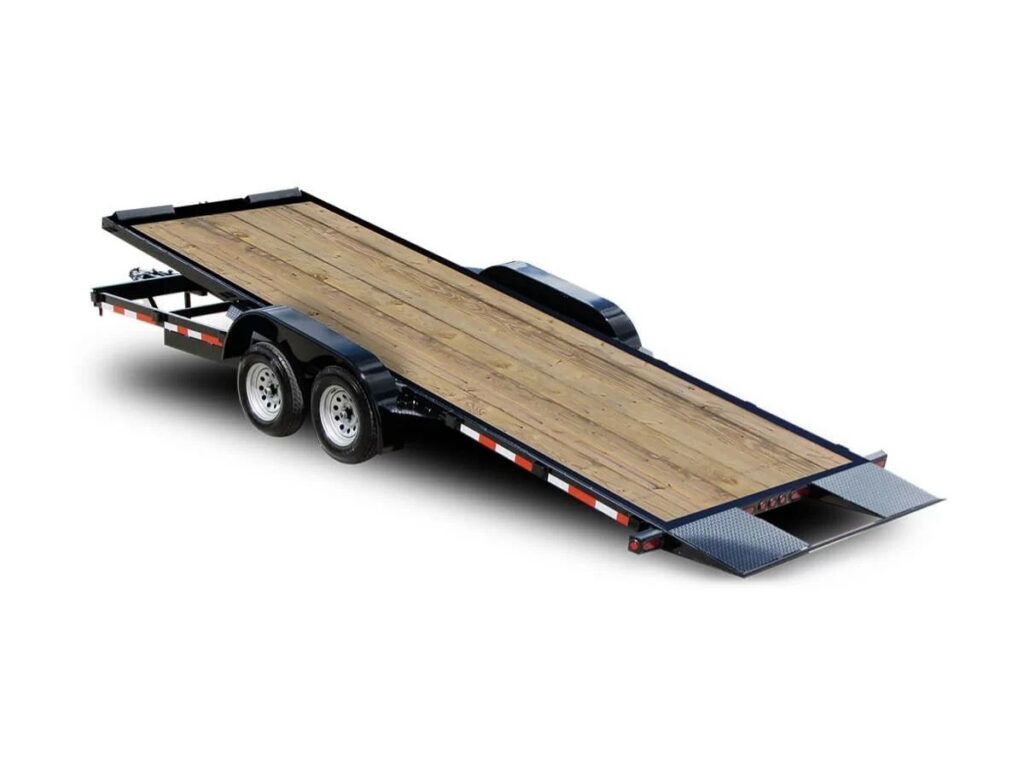
5. Car Hauler Trailer (Open Deck)
A car hauler trailer is built specifically to move cars.
It’s different from a flatbed because it usually has a lower deck, fender cutouts, and built-in ramps. The deck is open no roof or sides so it’s lighter and easier to load.
This trailer is made for transporting one or more vehicles safely and efficiently.
How It Works
You load from the back using pull-out ramps stored under the trailer.
Drive or winch the car up onto the deck. Then, use tie-down straps or wheel nets to secure it in place. Most models come with built-in D-rings or stake pockets for this.
I’ve used car hauler trailers on jobs where I needed to transport multiple cars in a day. They’re quick to load and unload, which keeps things moving.
Just keep in mind: there’s no cover. Rain, sun, and road debris can hit the car during travel.
Key Specs
- Axle Type: Tandem axles are common for carrying one or two cars. Some models may have triple axles for heavier loads.
- Deck Height: Low deck height—usually 18–24 inches—for easy loading.
- Towing Style: Most use a bumper pull hitch. Some longer or multi-car haulers use goosenecks.
Benefits
- Built for Cars: The low deck and ramp system make it safer and easier to load vehicles.
- Lightweight Frame: Because it’s open, it weighs less than enclosed trailers. That means better fuel use and less strain on your tow vehicle.
- Faster Turnaround: Loading and unloading is quick. Great if you’re moving more than one vehicle per day.
- Budget-Friendly: Lower cost compared to enclosed or tilt trailers.
- Visibility: Easier to keep an eye on your load during transport.
Ideal Users
- Individual Buyers: Great if you regularly move cars—whether for work, repairs, or resale.
- Dealerships and Distributors: Useful for moving vehicles between lots or to buyers.
- Auto Transport Companies: A workhorse trailer for local or regional moves.
- Repair Shops: Move customer vehicles without needing a tow truck.
- Construction or Industrial Buyers: Can work for UTVs, golf carts, or small machinery.
Decision Tip
Pick a car hauler trailer if your main goal is moving one or two vehicles fast and efficiently. But if you need protection from the elements or you’re hauling fragile cargo, an enclosed trailer may be the better call.
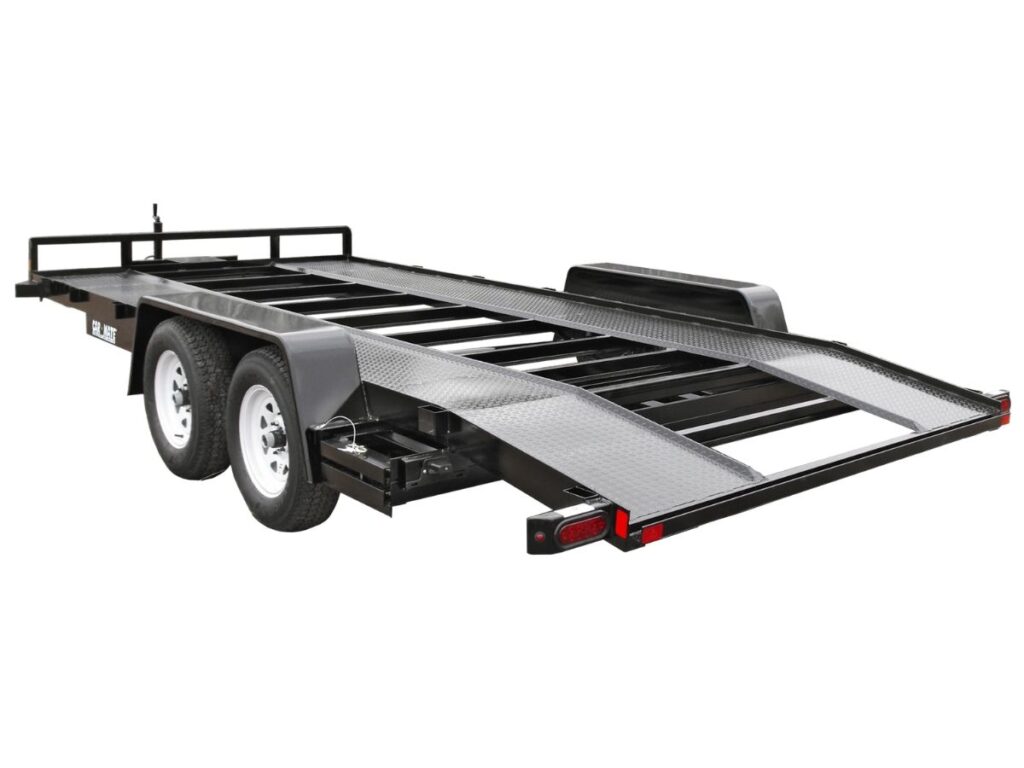
6. Gooseneck Car Trailer
A gooseneck car trailer connects to a hitch in the bed of your pickup truck not to the bumper like most trailers.
This hitch design gives better balance and allows the trailer to carry heavier loads.
Gooseneck trailers are often larger and longer. That makes them a smart choice for hauling multiple vehicles or heavy equipment.
If you’ve ever struggled with trailer sway or tight turns, switching to a gooseneck can feel like a big upgrade.
How It Works
The front of the trailer extends over your truck’s bed and locks onto a gooseneck ball hitch.
Once connected, the trailer weight is centered over the rear axle of your truck. This setup gives you more control and reduces sway, especially at higher speeds or in crosswinds.
Most gooseneck car trailers come with ramps, and some have hydraulic tilt decks for easier loading.
I once hauled two large SUVs across several provinces using a gooseneck. Long haul, tough weather. The trailer stayed steady the whole time, even on winding mountain roads. It made a stressful job feel manageable.
Key Specs
- Axle Type: Usually tandem or triple axles for high weight capacity
- Deck Height: Typically 24–30 inches, but varies by model and load
- Towing Style: Gooseneck hitch requires a pickup truck with a bed-mounted ball
Benefits
- Stability: Better weight distribution means less sway and safer handling
- Higher Payload: Designed for bigger loads more cars, more equipment
- Tighter Turning Radius: Easier to maneuver in small spaces than bumper-pull trailers
- Stronger Hitch Point: Reduces stress on your truck’s rear suspension
- Versatility: Some models also carry cargo, machines, or building materials
Ideal Users
- Logistics and Transport Fleets: Great for hauling multiple cars or equipment across long distances
- Construction Companies: Can handle heavier machinery and oversized gear
- Mining and Energy Industry: Good for rugged jobs and remote locations
- Large-Scale Farms: Useful for transporting tractors, tools, and supplies
- Experienced Individual Haulers: For those who need more capacity and already own a capable truck
Decision Tip
A gooseneck trailer is worth it if you haul heavy loads often and already have a pickup with a gooseneck hitch. But if you’re hauling light cargo or working in tight urban areas, a smaller bumper-pull trailer might be more practical.
And if you’re looking for a reliable gooseneck built for demanding work, Rhinotrail offers heavy-duty options trusted across industries.
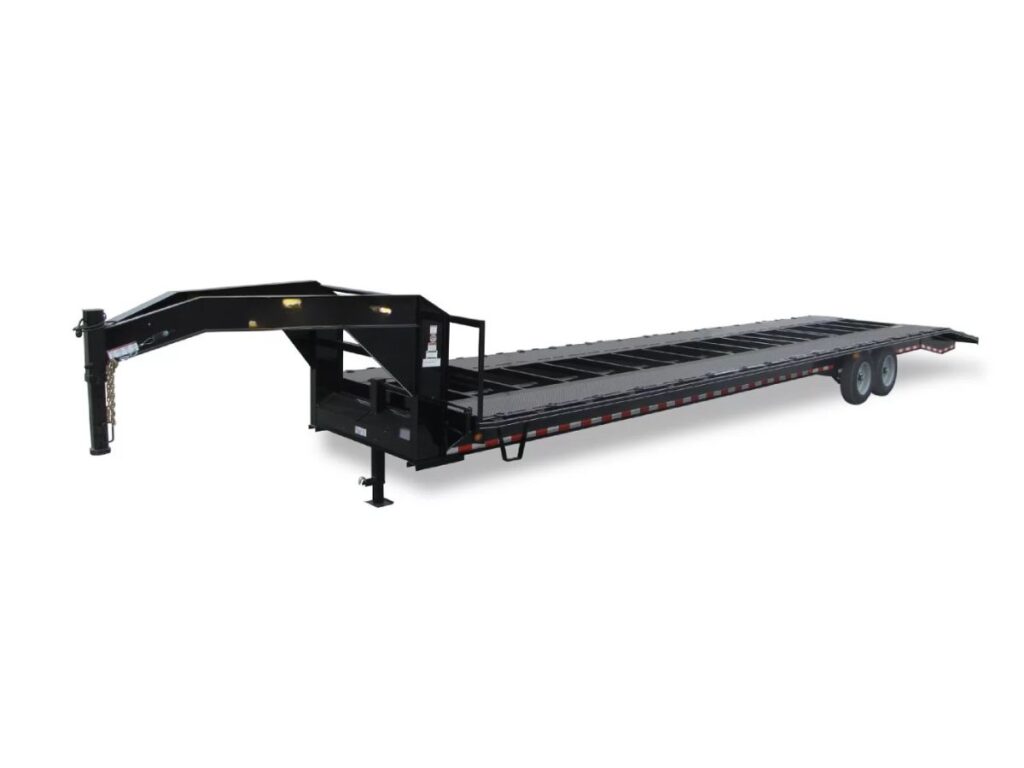
7. Bumper Pull Car Trailer
A bumper pull car trailer connects to a hitch ball at the back of your towing vehicle.
This is the most common trailer style you’ll see on the road. It’s smaller, simpler, and easier to use especially if you’re new to hauling.
Bumper pull trailers are made for light to medium loads. That makes them ideal for everyday jobs like moving one car or hauling small equipment.
How It Works
The trailer attaches to a standard hitch receiver near your vehicle’s bumper.
You’ll use a coupler that drops onto the hitch ball, then lock it in place with a pin and safety chains. Most setups also use an electric brake controller and trailer lights, which plug into your vehicle’s wiring.
Loading works like most open or flatbed trailers usually with ramps or tilt features.
I used a bumper pull when I first started out. I didn’t have a big truck, just a basic half-ton pickup. But it got the job done. Easy to hook up. Easy to park. And just enough capacity for what I needed at the time.
Key Specs
- Axle Type: Usually single or tandem axles depending on the size
- Deck Height: Around 20–24 inches for most models
- Towing Style: Bumper pull hitch (ball mount at the rear of the vehicle)
Benefits
- Beginner-Friendly: Simple to hitch, tow, and back up no special equipment needed
- Affordable: Often cheaper than gooseneck or enclosed trailers
- Versatile: Can be used for cars, ATVs, small machinery, or even general cargo
- Compatible with Most Vehicles: Works with SUVs, light trucks, and even some vans
- Takes Less Space: Easier to store in a garage or tight yard
Ideal Users
- Individual Buyers: Great for hobby haulers, weekend projects, or moving a personal vehicle
- Retail and Delivery Drivers: Can handle local deliveries and basic transport needs
- Small Construction Crews: Useful for moving tools and compact equipment
- Agricultural Users: Works for farm errands like hauling feed, fencing, or one small tractor
- New Trailer Owners: A solid starting point for anyone just getting into hauling
Decision Tip
Go with a bumper pull trailer if you want something simple, affordable, and easy to tow with a basic vehicle. But if you’re hauling heavy loads often or need more control at higher speeds, a gooseneck or larger trailer may serve you better.

8. Lowboy Trailer
A lowboy trailer is built with a very low deck height. The deck sits much closer to the ground than most other trailer types.
This design lets you haul tall or heavy equipment without going over legal height limits on the road.
Lowboys are often used in construction and heavy industry. They’re made to carry big machines like bulldozers, excavators, and other tall or oversized loads.
How It Works
A lowboy trailer has two drops in its frame, one right after the gooseneck, and one before the axles.
This “double drop” design creates a lower deck in the middle, which is where you load the vehicle or equipment.
Loading usually happens from the rear. You’ll use heavy-duty ramps or sometimes a detachable front section to make the process smoother.
I once helped move a compact wheel loader for a contractor using a lowboy. We couldn’t have done it with any other trailer. The height and weight were just too much for a standard flatbed.
Key Specs
- Axle Type: Usually tandem or triple axles for heavier weight limits
- Deck Height: As low as 18 inches at the center sometimes even lower
- Towing Style: Always gooseneck, due to the size and weight these trailers carry
Benefits
- Carries Tall Equipment: Keeps high loads within legal height limits, avoiding fines or special permits
- Stable for Heavy Loads: Lower center of gravity means safer hauling
- Built for Big Jobs: Can handle machines that other trailers simply can’t carry
- Legal Flexibility: Helps avoid height-related transport restrictions on public roads
- Wide Deck Space: Plenty of room for large machines or multiple small units
Ideal Users
- Construction Companies: Ideal for excavators, graders, loaders, and more
- Mining Industry: Can move heavy-duty equipment into tough work sites
- Energy Sector: Useful for hauling power units, tanks, or drilling gear
- Manufacturers: Works well for transporting tall factory machinery
- Experienced Operators: Best for those comfortable with heavy loads and gooseneck towing
Decision Tip
A lowboy trailer is the right choice if you’re hauling oversized or extra-tall equipment that won’t fit on other trailers. But if your loads are light or don’t exceed standard height, you probably don’t need this kind of setup. Stick with a flatbed or car hauler.
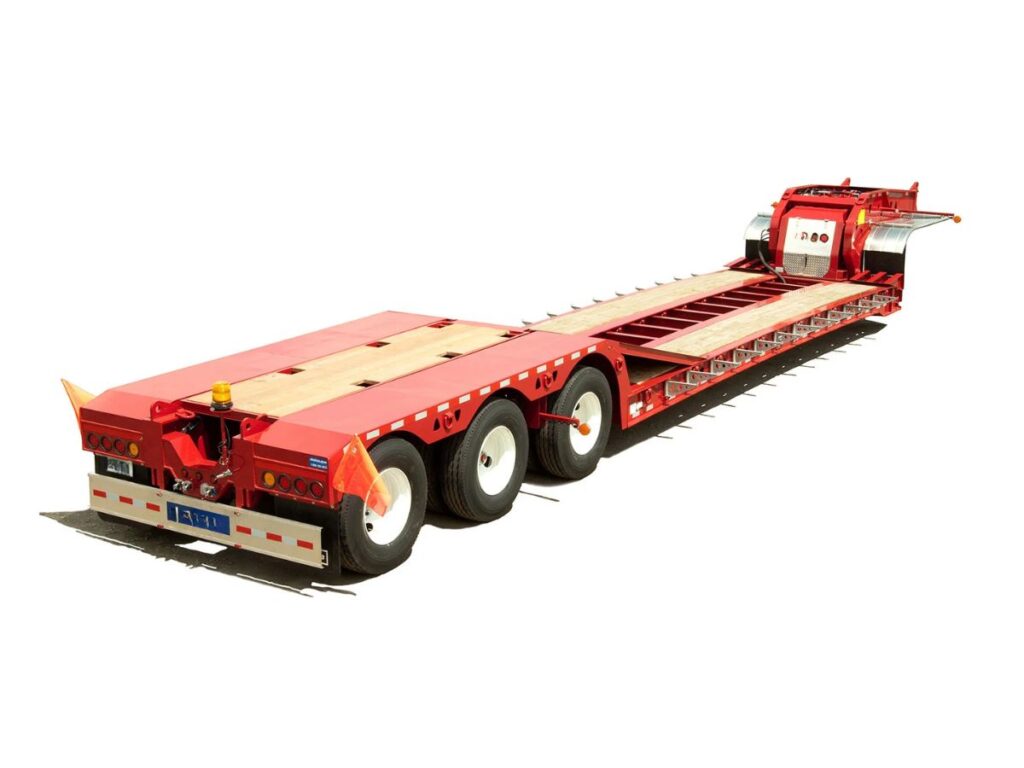
9. Deckover Trailer
A deckover trailer has a flat deck that sits above the wheels, instead of between them.
This design gives you a wider, flat surface with no fenders in the way. You get full use of the trailer’s width edge to edge.
Deckover trailers are made for hauling wide or oddly shaped loads that wouldn’t fit on standard car haulers.
How It Works
Because the deck is higher up, the loading process usually involves long ramps or loading from a dock.
Some models have built-in ramps that slide out from under the deck. Others might use detachable ramps you store separately.
I used a deckover once to haul a small tractor and several bundles of fencing for a farm job. The extra width gave me room to balance everything side by side without anything hanging over the edge.
You do have to be careful when loading because of the height, you’re working with a steeper angle.
Key Specs
- Axle Type: Tandem or triple axles depending on load weight
- Deck Height: Usually 32–36 inches above ground
- Towing Style: Most use bumper pull; heavy-duty models may use gooseneck
Benefits
- Full-Width Loading Space: No wheel wells means the entire deck is usable
- Wider Cargo Options: Great for hauling wider machines, pallets, or bundled materials
- Stronger Build: Most deckovers are built with steel frames for heavy-duty use
- Simpler Tie-Downs: Easier to strap cargo from any angle without working around fenders
- Multi-Purpose Use: Works for cars, tools, building supplies, and more
Ideal Users
- Construction Crews: Move wide equipment like skid steers, lifts, or building panels
- Agricultural Buyers: Useful for fencing supplies, hay bales, or compact tractors
- Logistics Companies: Haul irregular or oversized pallets that don’t fit standard trailers
- Manufacturers: Transport machines or goods that need flat, stable platforms
- Individual Buyers: Best if you haul mixed loads or wide cargo often
Decision Tip
A deckover trailer is a smart choice if you need a flat, wide surface and often deal with bulkier loads. But if you’re mostly hauling cars—or anything low to the ground you’ll have an easier time with a car hauler or tilt trailer.
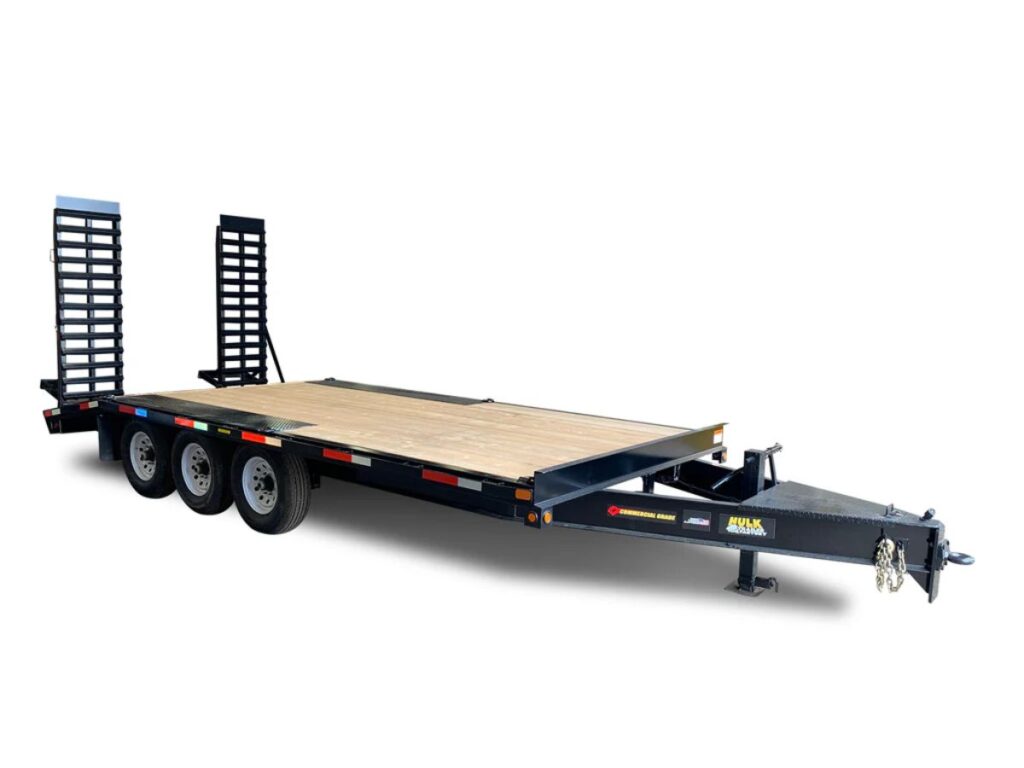
10. Tow Dolly
A tow dolly is a small trailer that lifts only the front wheels of a vehicle off the ground.
The back wheels stay on the road while the front is supported by the dolly.
Tow dollies are made for short- to medium-distance hauling. They’re especially useful when you’re moving a car behind an RV, pickup, or van.
This trailer is compact, lightweight, and simple to use great if you don’t have space or need to tow only once in a while.
How It Works
To use a tow dolly, you drive the front wheels of the car up onto the dolly ramps. Once in place, you secure the wheels using wheel straps or tire nets.
Most dollies come with built-in lights and safety chains. Some include surge brakes, which help stop the trailer using the motion of the tow vehicle.
I once used a tow dolly to help a friend move their old sedan across town. It was a quick setup no need for tie-downs everywhere. Just strap the front tires, check the lights, and go.
Just make sure the car you’re towing is front-wheel drive. If it’s rear- or all-wheel drive, you’ll need to disconnect the driveshaft—or skip the dolly entirely.
Key Specs
- Axle Type: Single axle under the loading platform
- Deck Height: Very low around 10–14 inches
- Towing Style: Bumper pull, fits most standard hitches
Benefits
- Lightweight: Easier to tow, even with smaller vehicles like SUVs or vans
- Compact: Takes up less space when parked or stored
- Fuel Efficient: Less weight and wind drag than full trailers
- Quick Setup: No need for loading ramps or winches
- Budget-Friendly: Usually cheaper than full-size trailers to buy or rent
Ideal Users
- Individual Buyers: Great for short moves or emergency towing
- RV Owners: Handy for bringing a small car along on long road trips
- Repair Shops: Easy way to pick up non-damaged, front-wheel-drive vehicles
- Used Car Dealers: Good for short-distance deliveries
- Fleet Managers: Useful for moving light-duty vehicles without a full trailer
Decision Tip
A tow dolly is a great match if you’re hauling a front-wheel-drive car and need a lightweight, affordable solution. But if you’re moving AWD or rear-wheel-drive vehicles or driving through bad weather you’ll want a full car trailer instead.
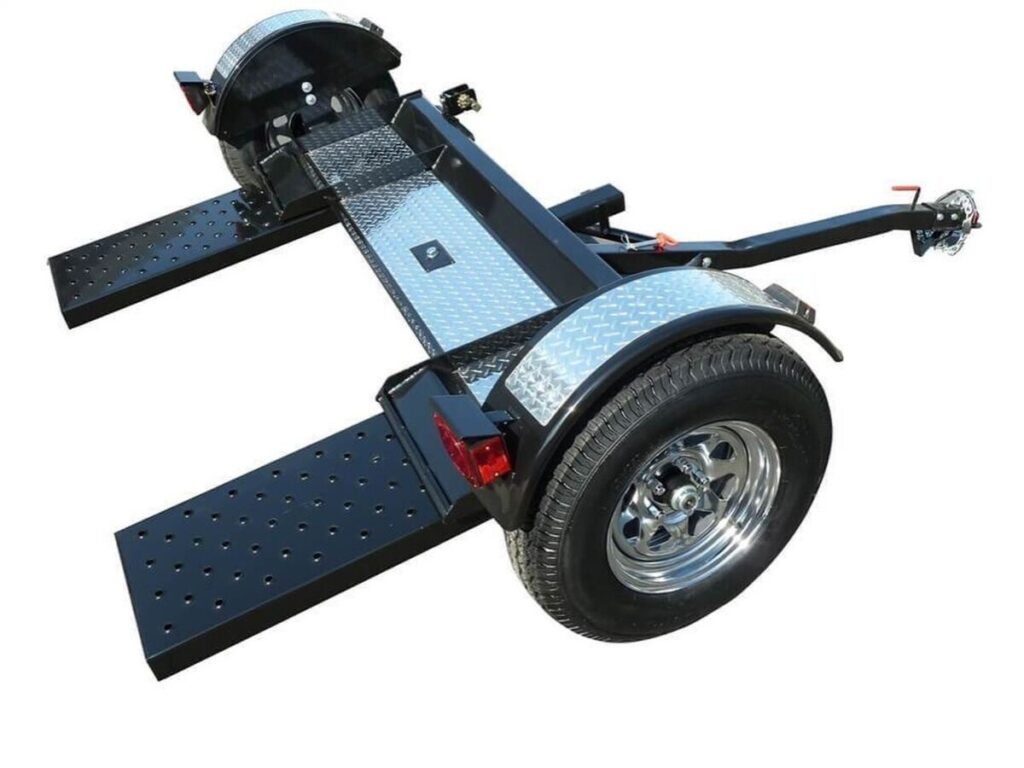
11. Fifth-Wheel Car Trailer
A fifth-wheel car trailer is a heavy-duty trailer that connects to a hitch mounted in the bed of a pickup truck, right above the rear axle.
This hitch style is similar to what semi-trucks use. It offers better control and higher weight capacity than bumper pull or gooseneck setups.
Fifth-wheel trailers are built for long hauls, heavy loads, and stable towing. You’ll often see them in professional transport jobs where safety and strength matter most.
How It Works
The trailer connects to a fifth-wheel hitch inside the truck bed. This hitch locks into a kingpin on the trailer’s front end.
This setup shifts the trailer’s weight directly over the truck’s rear wheels, giving you better balance and reducing sway.
Most fifth-wheel car trailers come with loading ramps. Some also have tilt decks or hydraulic lift systems for easier access.
I helped a friend transport two off-road vehicles using a fifth-wheel trailer. The roads were long and full of curves, but the trailer handled them with ease. The difference in stability compared to a bumper pull was night and day.
Key Specs
- Axle Type: Tandem or triple axles for high payloads
- Deck Height: Typically 28–32 inches, depending on model
- Towing Style: Fifth-wheel hitch (requires compatible pickup truck)
Benefits
- Increased Stability: The hitch position reduces sway and improves turning
- Higher Weight Capacity: Built for heavier loads and longer vehicles
- Better Maneuvering: Easier to reverse and turn tight corners compared to bumper pull trailers
- Long-Term Durability: Made for heavy, regular use
- More Deck Options: Can include enclosed, flatbed, or specialty setups
Ideal Users
- Professional Haulers: Best for those who transport multiple or heavy vehicles
- Construction and Mining Operations: Can move heavy-duty machines or support trucks
- Fleet Operators: Ideal for long-haul vehicle delivery or equipment transport
- Manufacturers: Helpful for moving large products or machinery to job sites
- Experienced Individual Buyers: Great if you already own a truck with a fifth-wheel hitch
Decision Tip
Go with a fifth-wheel car trailer if you haul heavy or multiple vehicles often and already have a capable truck setup. But if your loads are light or occasional, a bumper pull or gooseneck trailer will likely be more practical and easier to manage.
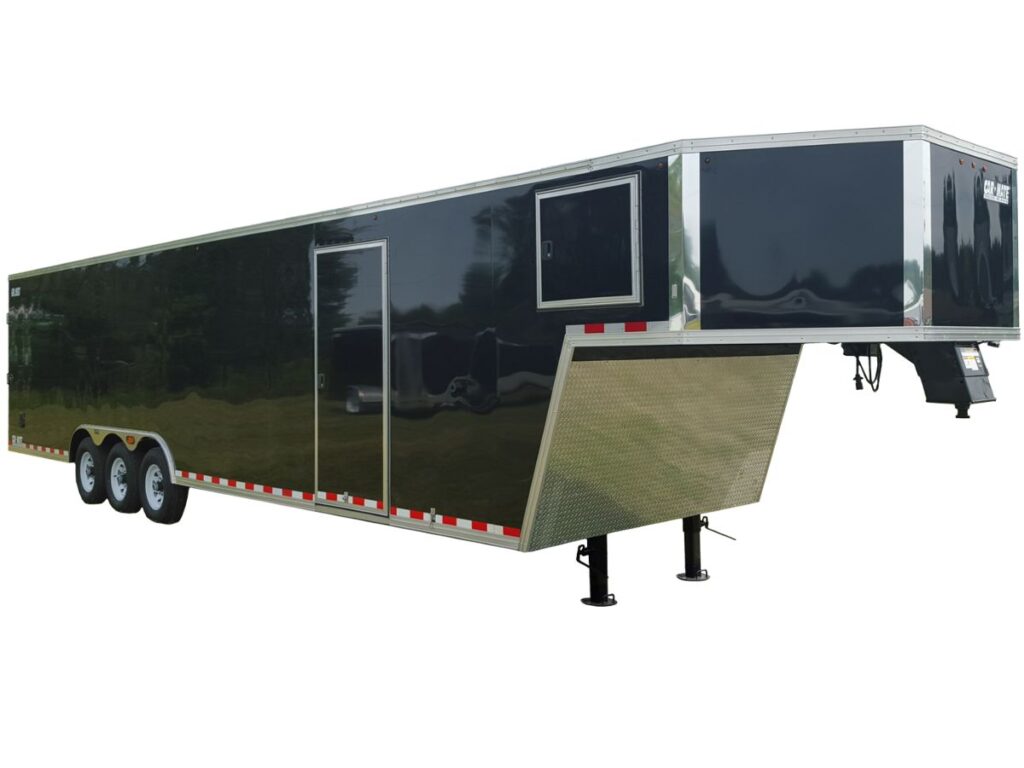
Conclusion
You don’t have to keep guessing which trailer fits your needs.
Now you’ve got the full picture 10 trailer types, real examples, and honest advice.
Whether you’re in construction, farming, logistics, or just moving your own car, the right trailer makes your job smoother, safer, and faster.
So what’s stopping you?
Start with what you need to move. Then match it to what you just learned.
And if it still feels unclear let’s talk.
Contact us today and we’ll help you choose smart.


